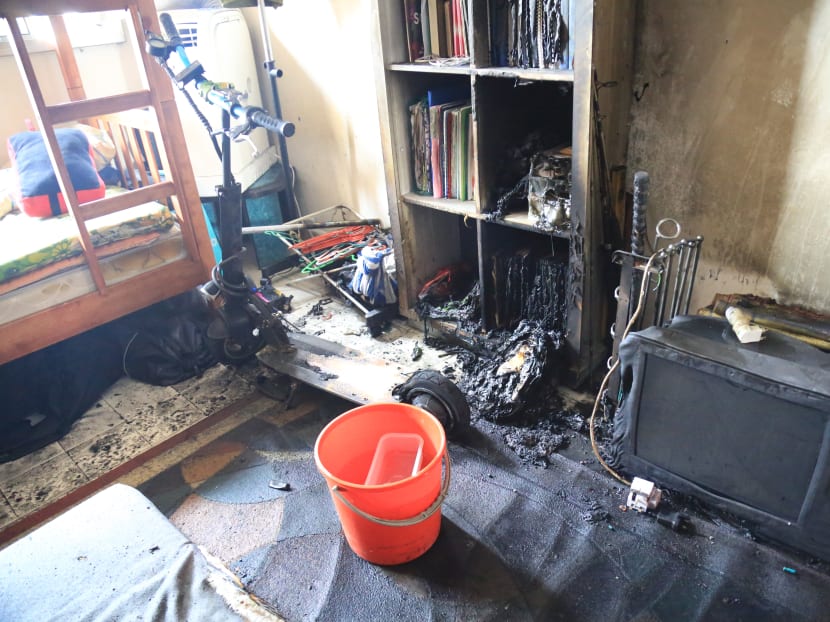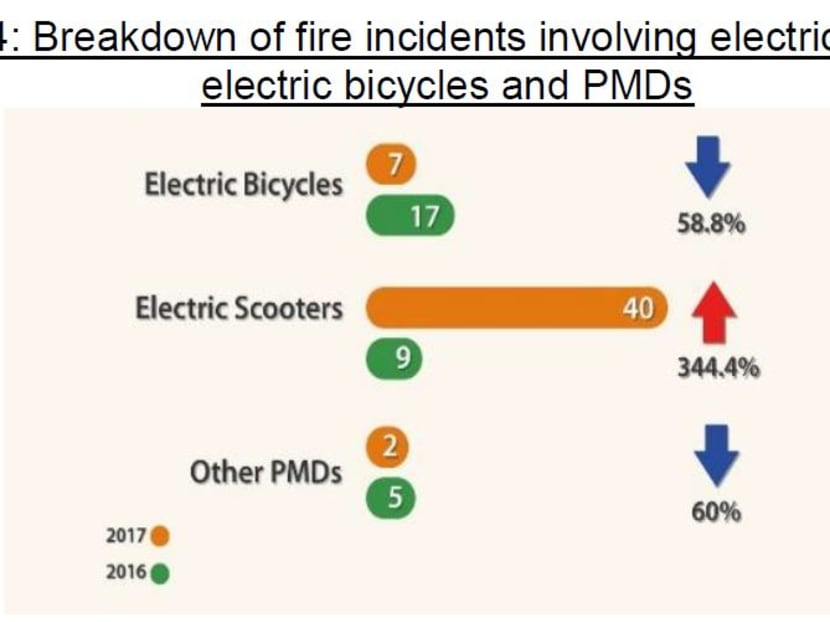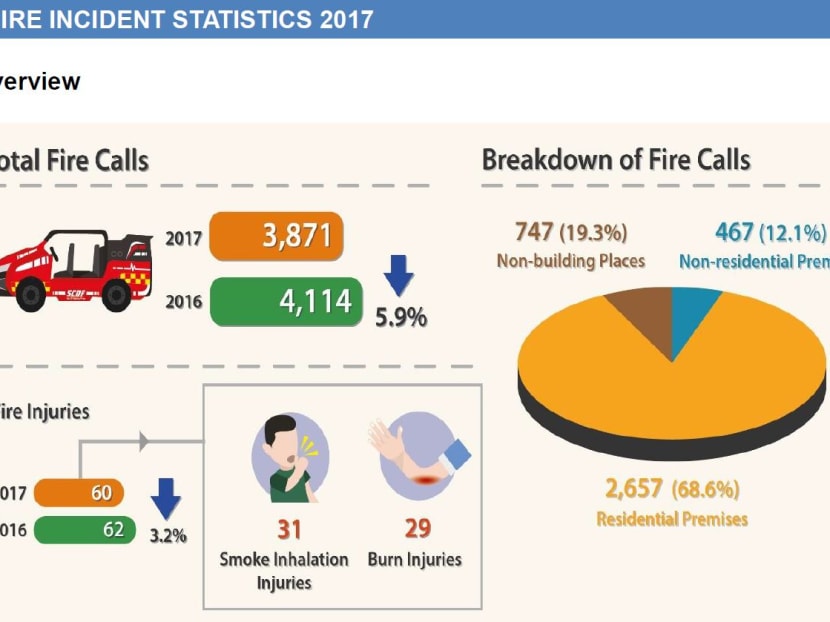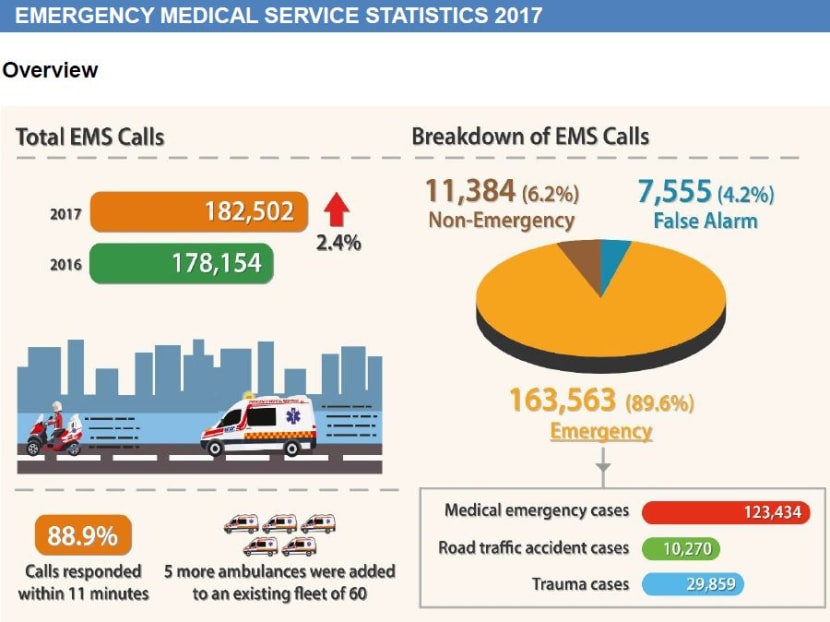E-scooter fires soar 300% in 2017 even as fire cases hit 40-year low: SCDF
SINGAPORE — The number of fires involving electric scooters last year shot up more than 300 per cent, even as the number of fire calls island-wide hit a 40-year low.

A fire, which was started by an e-scooter left charging in a bedroom of a residential unit at Block 260 Yishun Street 22, damaged the bedroom and injured four residents. Photo: SCDF
SINGAPORE — The number of fires involving electric scooters last year shot up more than 300 per cent, even as the number of fire calls island-wide hit a 40-year low.
Releasing its annual fire, ambulance and enforcement statistics on Friday (Feb 9), the Singapore Civil Defence Force (SCDF) flagged e-scooter fires as an area of concern as the number of cases soared from just nine in 2016 to 40 — or a 344.4 per cent spike — last year.
The number of fires involving electric bicycles and other personal mobility devices (PMDs), which were highlighted as a rising trend in 2016, have fallen. E-bike fires dropped 58.8 per cent, from 17 in 2016 to seven last year, while fires involving other PMDs declined 60 per cent, from five in 2016 to two last year.
The rechargeable lithium ion batteries, used by most e-scooters, e-bicycles and PMDs, have high energy density and flammable internal materials, said the SCDF. And battery fires could be caused by faulty electrical circuitry or overcharging of rechargeable batteries, leading to the PMDs catching on fire.
The SCDF is working with agencies such as Spring Singapore and the LTA to deal with “various aspects on the regulation of batteries and adapters, to the use and safety aspects of it”, said Assistant Commissioner Ling Young Ern, head of operations at SCDF. He declined to provide more details.
PMD users should not charge their devices overnight, or in close proximity to combustible items such as sofas and other furniture, said SCDF fire investigation unit commander Shaiful Herman.
“They should also never tamper with, modify or even do repair work on their own devices, in particular the electrical components within the PMDs,” Lieutenant-Colonel Shaiful added.

Overall, the number of fire calls the SCDF responded to last year — 3,871 — was the lowest recorded in 40 years since 1978, when there were 4,174 calls.
The small drop from the 4,114 calls in 2016 was largely due to the fall in the number of rubbish, vehicle and vegetation fires, the SCDF said.
Almost three-quarters of fire calls last year happened in residential premises, with the top three types being rubbish, unattended cooking and discarded items.
Rubbish fires continued to form the bulk of residential fires, though it decreased by 14 per cent between 2016 and 2017. Fires from discarded items, which usually occur at common areas such as lift lobbies and staircase landings, rose 16 per cent between the same period.
Half of all fires were caused by the improper disposal of lighted materials, such as cigarette butts that were not completely extinguished, lighted incense sticks and charcoal embers.

There were three fatalities and 60 injuries from fires last year, compared to two fatalities and 62 injuries from fires in 2016. The fatalities arose from a flash fire at Circuit Road in April, an industrial building fire at Toh Guan Road in May, and a residential fire at Ang Mo Kio Avenue 6 in June.
Vehicle fires dropped by 22 per cent to 184 cases last year, compared to 236 in 2016.
The number of 995 — or Emergency Medical Service (EMS) — calls that the SCDF responded to last year went up 2.4 per cent to 182,502, compared to 178,154 in 2016.
Of these calls, almost 90 per cent were emergency calls, 6 per cent were non-emergency calls and 4 per cent were false alarms.
Three-quarters of emergency calls were medical-related, such as cardiac arrest and chest pain, while 6 per cent were related to road traffic accidents.
The remaining 18 per cent were trauma cases such as industrial accidents and falls.
The number of calls involving the elderly, aged 65 and above, remained the highest among all age categories at 41.9 per cent.
The SCDF responded to 88.9 per cent of EMS calls within 11 minutes and added five ambulances to its EMS fleet, bringing its total number to 65.

Noting that the number of such calls have “continued the relentless upward climb since 1998”, its spokesman said “it further affirms the need for SCDF’s tiered response framework, so that scarce resources can be prioritised for the more urgent, severe cases”.
Giving an update on the framework, which was introduced on April 1 last year, the SCDF has started assessing the urgency of the calls via telephone medical triaging, and have more than 230 fire and rescue specialists (FRS) trained as emergency medical technicians (EMT) since 2013.
These FRS-EMTs can respond to a variety of medical emergencies on SCDF’s fire bikes and fire medical vehicles (FMVs).
Between April and December last year, FRS-EMTs on fire bikes responded to 12,033 life-threatening cases, while SCDF’s fleet of six FMVs responded to 122 incidents from May to December last year.
The SCDF also conducted 14,802 fire safety enforcement checks last year, and issued 2,845 notices of fire safety offences, and 2,543 fire hazard abatement notices.








